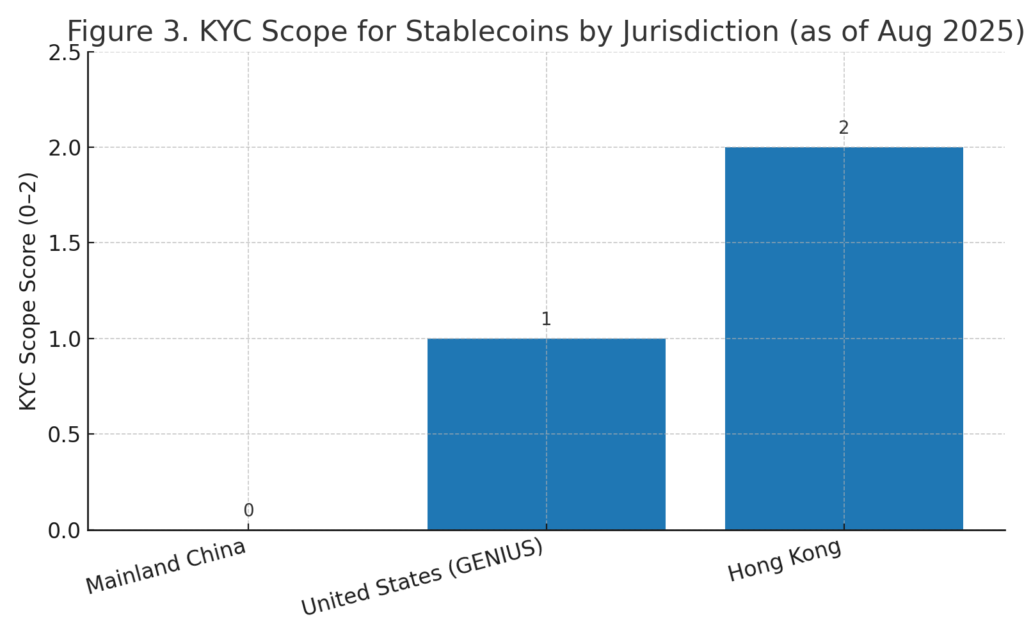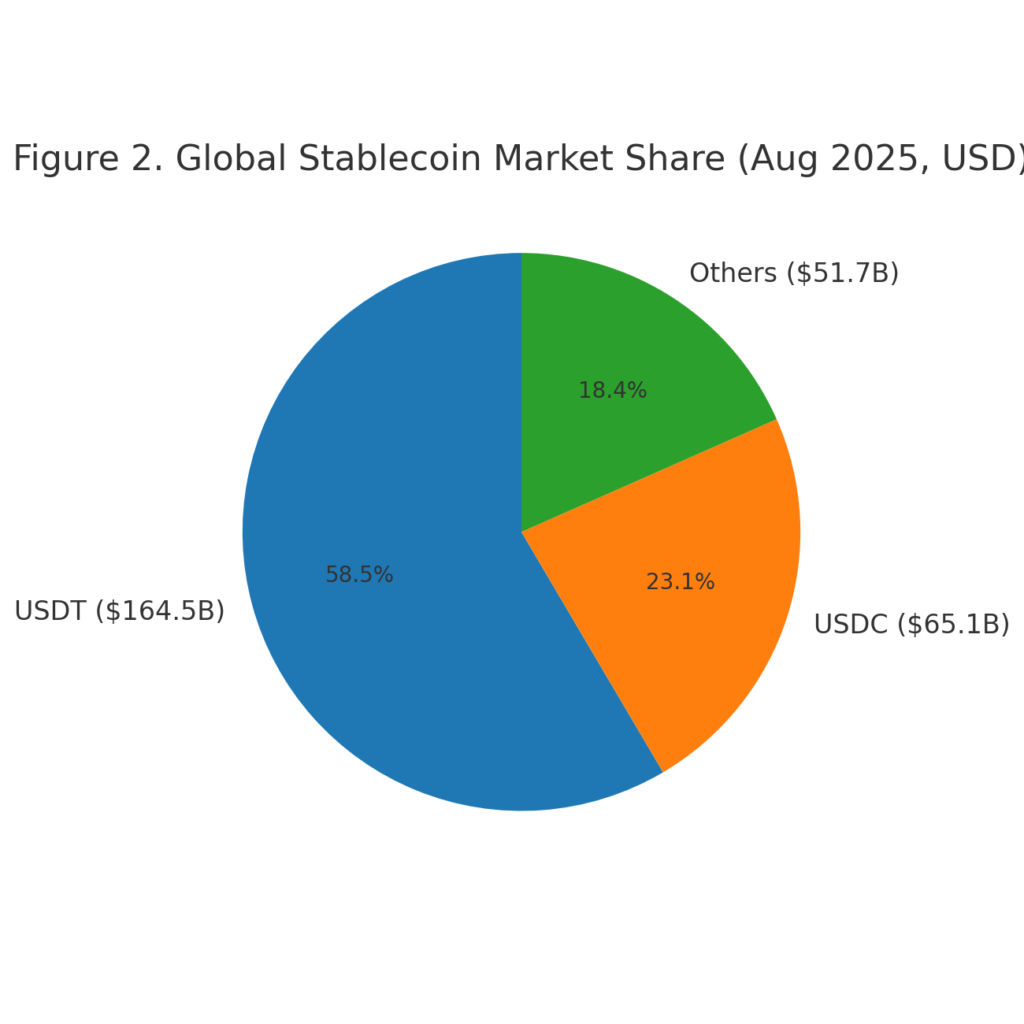
Main points:
- Beijing just told local brokers and think tanks to stop publishing stablecoin research and cancel seminars, citing the risk of scams and herd speculation—another turn of the screw after years of crypto restrictions.
- Hong Kong’s stablecoin regime took effect on August 1, 2025, with strict licensing, reserve, and KYC requirements that extend to “every token holder,” plus a transitional window for pre-existing issuers. First licenses are expected early next year.
- Traditional finance is walking in: Standard Chartered set up a JV with Animoca Brands and HKT to issue an HKD-backed stablecoin under the new framework. JD.com registered stablecoin-linked entities, and Ant International is exploring license applications in Hong Kong and Singapore.
- China-linked “offshore CNH” is a separate track: Conflux unveiled a stablecoin pegged to the offshore renminbi (CNH) aimed at Belt and Road cross-border payments—explicitly outside the mainland.
- The U.S. set a global marker with the GENIUS Act (July 18, 2025)—full backing in liquid assets and monthly reserve disclosures for payment stablecoins, with a federal licensing/supervisory regime.
- Market reality: USD-backed coins still dominate. Around $164.5B USDT and ~$65B USDC lead a stablecoin market of roughly $281B as of early August 2025.
[Insert Figure 1 here.]

What exactly did Beijing do?
In early August, multiple major brokerages and related bodies in mainland China received guidance from financial regulators to halt research that endorses stablecoins and to cancel related seminars. The intent, sources said, is to cool a surge in interest and to prevent misuse in fraud, gambling, and underground banking. While crypto trading has been banned on the mainland since 2021, investor inquiries reportedly intensified after Hong Kong finalized a licensing regime for fiat-referenced stablecoins.
This move follows a broader tightening on cross-border capital flows and online gambling, with banks told to monitor, flag, and report risky FX and crypto-linked transactions—especially those tied to underground channels. That posture makes it harder for mainland users to move value via digital assets, even as interest in stablecoins ramps globally.
Why now? Fraud, flight, and the politics of stability
To regulators, stablecoins can look like shadow dollars: frictionless, liquid, and global. That’s useful for legitimate commerce and remittances—but also appealing to scammers and capital-flight schemes. The mainland’s approach is therefore consistent with capital controls: discourage tools that could facilitate outflows or unmonitored cross-border activity, even if those tools are increasingly mainstream elsewhere.
Hong Kong’s different bet: strict licensing, strict KYC, institutional rails
Hong Kong has gone the other direction—legalizing and licensing fiat-referenced stablecoin issuance beginning August 1, 2025, with an unusually strict KYC requirement that issuers verify the identity of every token holder. Policymakers argue this is essential for AML/CFT, even if it raises frictions for users of unhosted wallets. The first batch of licenses is expected early next year, with the HKMA signaling only a handful at launch.
The HKMA also published transitional provisions for pre-existing issuers (those with meaningful operations before August 1). In brief: apply within three months and, if preliminarily qualified, operate under a time-bound allowance (often described as a non-contravention or provisional license phase) that can extend operations for several months—a bridge into full licensing.
[Insert Figure 3 here.]

What this means for builders: Hong Kong is open but heavyweight. Expect deep compliance work (reserves, governance, disclosures, segregation/custody, and especially all-holder KYC). The flip side: bankable rails and institutional appetite.
Who’s moving first: banks and Big Tech adjacent
- Standard Chartered x Animoca x HKT JV. Standard Chartered Bank (Hong Kong) Limited teamed up with Animoca Brands and HKT to form a joint venture targeting an HKD-backed stablecoin license—first announced in February 2025 and reaffirmed after the law took effect. For crypto-native builders, this is the signal: traditional rails will co-exist with Web3 stacks.
- JD.com’s “Coinlink” push. JD registered entities linked to “Jcoin/Joycoin” ahead of the law’s commencement, reportedly via its JD Coinlink Technology arm. Whether the initial focus is HKD or USD rails, the direction is clear: major platform companies want stablecoin optionality in Hong Kong.
- Ant International’s options. The Ant Group affiliate has said it is seriously considering stablecoin licenses in multiple jurisdictions, including Hong Kong and Singapore—a sign that regional fintech champions are positioning for regulated issuance and distribution.
The offshore-RMB experiment: CNH-pegged rails (outside the mainland)
Another notable thread is offshore renminbi (CNH) stablecoins. Conflux unveiled plans for a CNH-pegged coin with partners AnchorX and Eastcompeace, aimed at Belt-and-Road settlement corridors. The emphasis is offshore—not for onshore retail use—aligning with Beijing’s goals to internationalize the RMB without loosening domestic controls. For exporters and logistics platforms in BRI countries, this could be a low-friction working-capital rail—if correspondent networks and KYC stacks are robust.
The U.S. countercurrent: the GENIUS Act’s federal framework
On July 18, 2025, the U.S. enacted the GENIUS Act, the first federal stablecoin law. It mandates full, high-quality reserves, monthly public reserve disclosures, and establishes federal licensing/supervision for payment stablecoin issuers (with pathways for foreign issuers to participate under U.S. standards). This raises the bar for transparency and pushes the market toward bank-grade attestations and publisher accountability.
For stablecoin businesses, GENIUS will likely:
- Compress compliance arbitrage—issuers will gravitate to jurisdictions where reserves, disclosure cadence, and prudential oversight are recognized by banks and large corporates.
- Lower acceptance friction with U.S. counterparties (treasury, payables, and fintech banks), particularly for B2B settlement and merchant acquiring.
Market structure snapshot: why USD rails still dominate
Despite diverse experiments (EUR, CNH, HKD), USD-backed coins remain the liquidity and settlement standard. As of early August:
- USDT ≈ $164.5B market cap,
- USDC ≈ $65B,
- Total stablecoin category ≈ $281B (so “others” ≈ $52B combined).
[Insert Figure 2 here.]

The implications for yield seekers and builders:
- Liquidity gravity: Most DEX pairs, CEX books, and on-chain money markets anchor in USD stablecoins. That’s where the deepest order books, predictable spreads, and enterprise integrations sit.
- Compliance premium: With GENIUS and Hong Kong’s regime live, transparent, fully-backed USD coins will likely price tighter on OTC desks and win corporate treasurers—translating into lower slippage and faster onboarding.
Practical playbooks for teams and investors
1) For issuers and fintechs targeting Hong Kong
- License planning: Prepare for all-holder KYC design. Decide whether to operate issuer-hosted wallets or require users to onboard via licensed partners—either way, your AML/KYC perimeter must cover holders, not just direct customers.
- Reserves & disclosure: Align with bank-grade reserve custody/segregation and a disclosure cadence that meets HKMA expectations. (Leverage your GENIUS-grade reporting stack if you plan U.S. distribution too.)
- Institutional go-to-market: Engage HK clearing banks and payment companies early; HKMA expects few initial licenses, so partnerships and operational readiness matter.
2) For cross-border B2B platforms (BRI, trade finance, logistics)
- CNH offshore rails can compress settlement latency and FX friction, but counterparties and custody must be outside the mainland. Validate KYC/AML and correspondent coverage in your specific lanes (e.g., Central Asia, Middle East).
- Manage policy risk: Mainland policy won’t allow retail onshore use; plan for ring-fenced flows with clear jurisdictional firebreaks.
3) For exchanges and wallets serving Chinese-speaking markets
- Content risk management: The mainland has now chilled not just trading but public discourse/education by regulated financial firms around stablecoins. Audit your research, webinars, and marketing if you have team members or entities onshore.
- Hong Kong bridge: Consider HK entity alignment for product/marketing that references stablecoins; keep onshore China completely segregated operationally and in content distribution.
What to watch next
- Who gets the first HK licenses (and how many)—HKMA has telegraphed “a handful,” with early emphasis on B2B.
- U.S. rulemaking under GENIUS—details of attestations, custody, and cross-border participation will shape bank integrations and corporate adoption.
- CNH stablecoin uptake in specific trade corridors—pilot volumes, settlement SLAs, and counterparty breadth will determine real utility beyond headlines.
- Mainland enforcement—expect continued scrutiny of FX/crypto channels (underground banks, online gambling), plus spells of public messaging to deter retail speculation.
Conclusion: Two tracks, one destination
Mainland China’s latest guidance is a clear deterrent to stablecoin hype onshore, consistent with a multi-year campaign to police cross-border money flows. Hong Kong, conversely, has opened a licensed, KYC-heavy corridor for institutional-grade stablecoins—and global finance (from Standard Chartered to JD.com and Ant International) is taking its starting positions. Meanwhile, the U.S. GENIUS Act gives dollar-backed issuers a federal home with strong reserve and disclosure rules.
For builders and investors focused on new assets, income streams, and practical blockchain use, the path is emerging:
- If you want RMB exposure, think offshore CNH with strict jurisdictional walls.
- If you want institutional on-ramps, prepare for Hong Kong’s all-holder KYC and U.S. GENIUS-grade transparency.
- If you want liquidity, the USD rails (USDT/USDC) still rule—and will likely rule harder as compliance matures.

